Marketing Report: Analyzing and Recommending for Tata Nano
VerifiedAdded on 2023/06/03
|12
|2663
|445
Report
AI Summary
This report provides an in-depth analysis of the marketing strategies employed by Tata Motors for the Tata Nano, a budget-friendly compact car launched in 2008. The report begins with an executive summary and a company recap, highlighting Tata Motors' position in the automotive industry. It then delves into the marketing strategies, including target market segmentation, positioning, and the marketing mix (product, price, place, promotion, people, processes, and physical evidence). The report examines the challenges faced by the Nano, such as factory relocation, safety concerns, and quality issues, which led to its eventual discontinuation. It offers recommendations for re-launching the Nano, including product differentiation, environmental considerations (electric engine), and targeting specific consumer segments through digital marketing. The report concludes with a summary of the key findings and recommendations, emphasizing the importance of brand loyalty and strategic marketing for the Nano's success.

Principles of Marketing 1 | P a g e
Principles of Marketing
Principles of Marketing
Paraphrase This Document
Need a fresh take? Get an instant paraphrase of this document with our AI Paraphraser
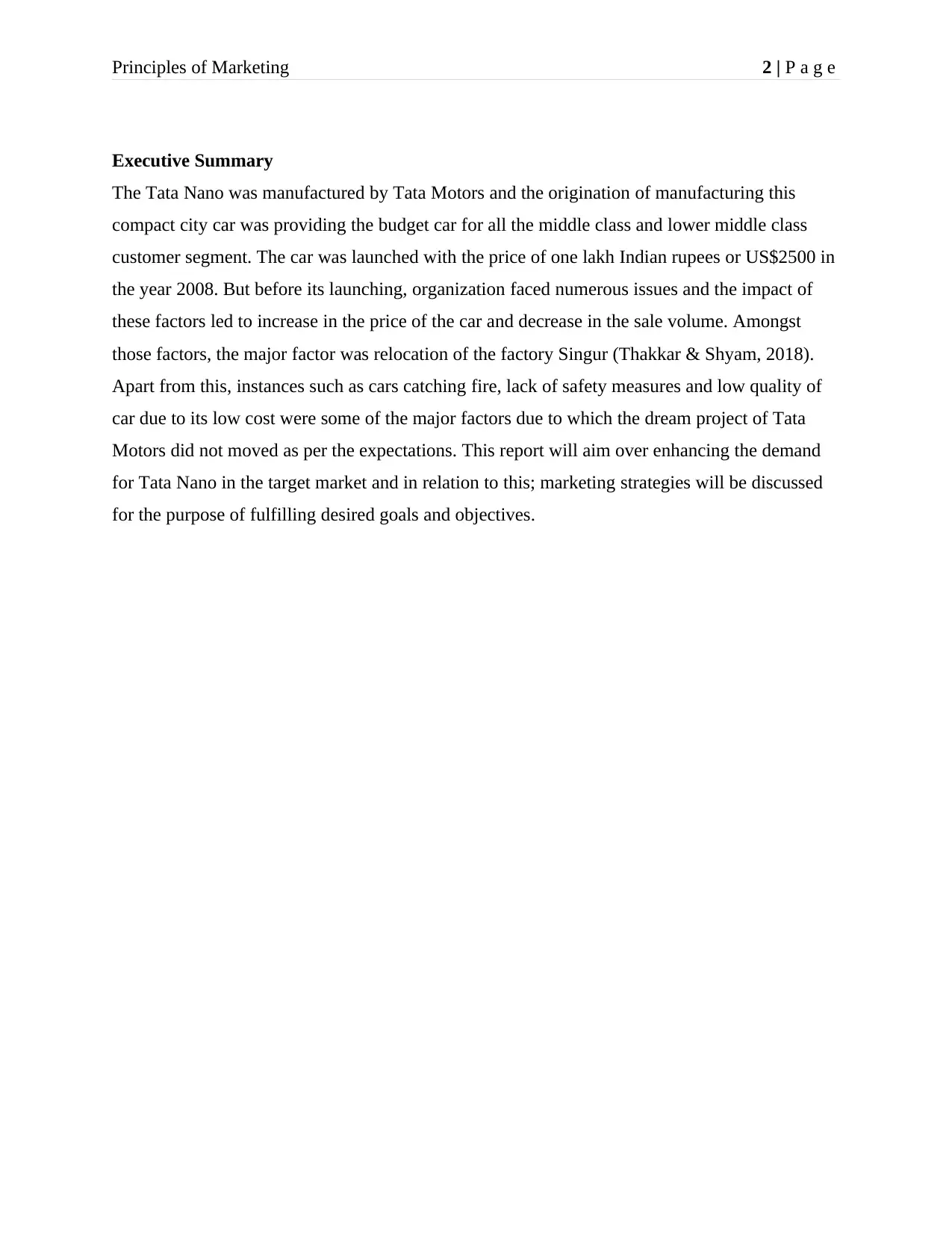
Principles of Marketing 2 | P a g e
Executive Summary
The Tata Nano was manufactured by Tata Motors and the origination of manufacturing this
compact city car was providing the budget car for all the middle class and lower middle class
customer segment. The car was launched with the price of one lakh Indian rupees or US$2500 in
the year 2008. But before its launching, organization faced numerous issues and the impact of
these factors led to increase in the price of the car and decrease in the sale volume. Amongst
those factors, the major factor was relocation of the factory Singur (Thakkar & Shyam, 2018).
Apart from this, instances such as cars catching fire, lack of safety measures and low quality of
car due to its low cost were some of the major factors due to which the dream project of Tata
Motors did not moved as per the expectations. This report will aim over enhancing the demand
for Tata Nano in the target market and in relation to this; marketing strategies will be discussed
for the purpose of fulfilling desired goals and objectives.
Executive Summary
The Tata Nano was manufactured by Tata Motors and the origination of manufacturing this
compact city car was providing the budget car for all the middle class and lower middle class
customer segment. The car was launched with the price of one lakh Indian rupees or US$2500 in
the year 2008. But before its launching, organization faced numerous issues and the impact of
these factors led to increase in the price of the car and decrease in the sale volume. Amongst
those factors, the major factor was relocation of the factory Singur (Thakkar & Shyam, 2018).
Apart from this, instances such as cars catching fire, lack of safety measures and low quality of
car due to its low cost were some of the major factors due to which the dream project of Tata
Motors did not moved as per the expectations. This report will aim over enhancing the demand
for Tata Nano in the target market and in relation to this; marketing strategies will be discussed
for the purpose of fulfilling desired goals and objectives.
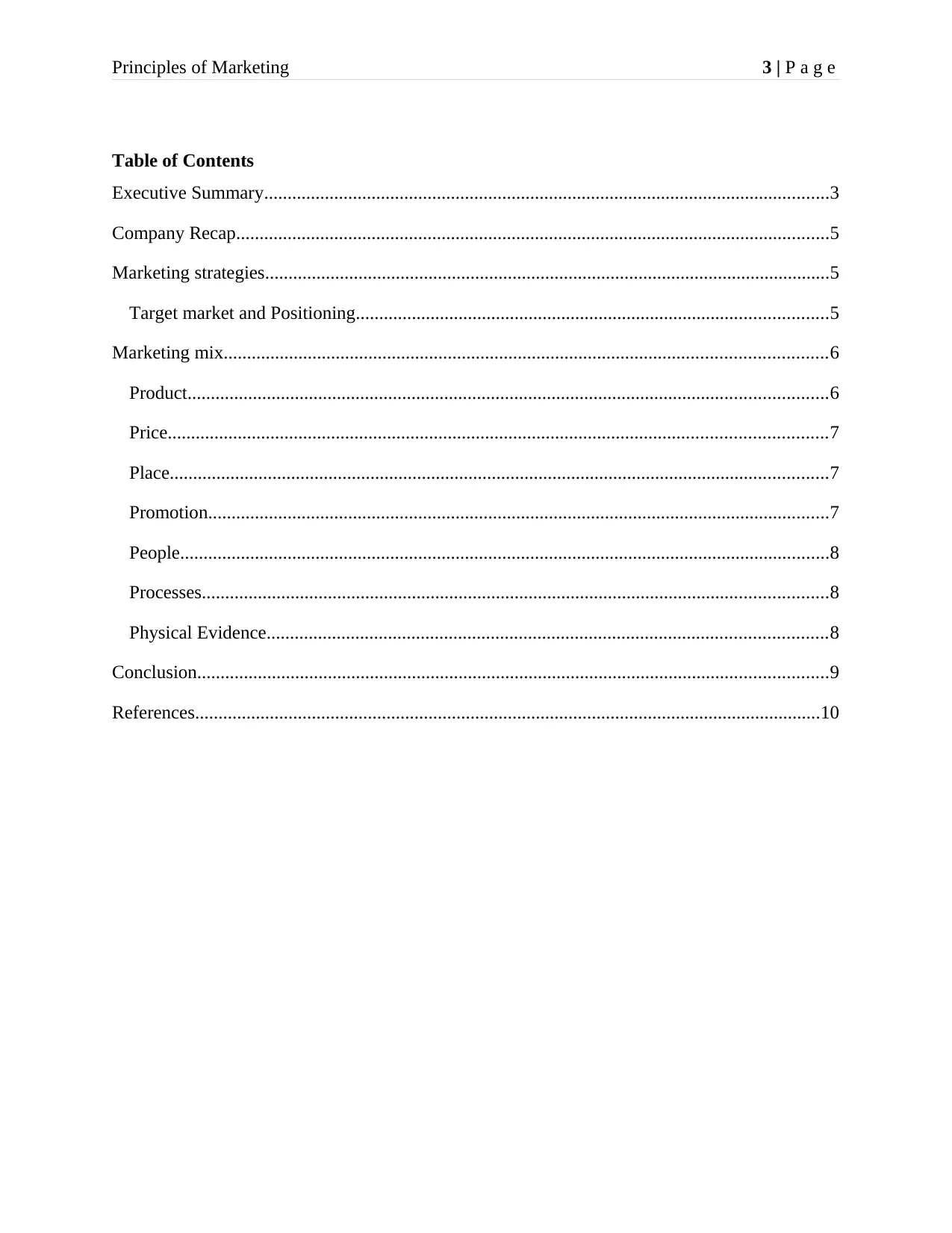
Principles of Marketing 3 | P a g e
Table of Contents
Executive Summary.........................................................................................................................3
Company Recap...............................................................................................................................5
Marketing strategies.........................................................................................................................5
Target market and Positioning.....................................................................................................5
Marketing mix.................................................................................................................................6
Product.........................................................................................................................................6
Price.............................................................................................................................................7
Place.............................................................................................................................................7
Promotion.....................................................................................................................................7
People...........................................................................................................................................8
Processes......................................................................................................................................8
Physical Evidence........................................................................................................................8
Conclusion.......................................................................................................................................9
References......................................................................................................................................10
Table of Contents
Executive Summary.........................................................................................................................3
Company Recap...............................................................................................................................5
Marketing strategies.........................................................................................................................5
Target market and Positioning.....................................................................................................5
Marketing mix.................................................................................................................................6
Product.........................................................................................................................................6
Price.............................................................................................................................................7
Place.............................................................................................................................................7
Promotion.....................................................................................................................................7
People...........................................................................................................................................8
Processes......................................................................................................................................8
Physical Evidence........................................................................................................................8
Conclusion.......................................................................................................................................9
References......................................................................................................................................10
⊘ This is a preview!⊘
Do you want full access?
Subscribe today to unlock all pages.

Trusted by 1+ million students worldwide
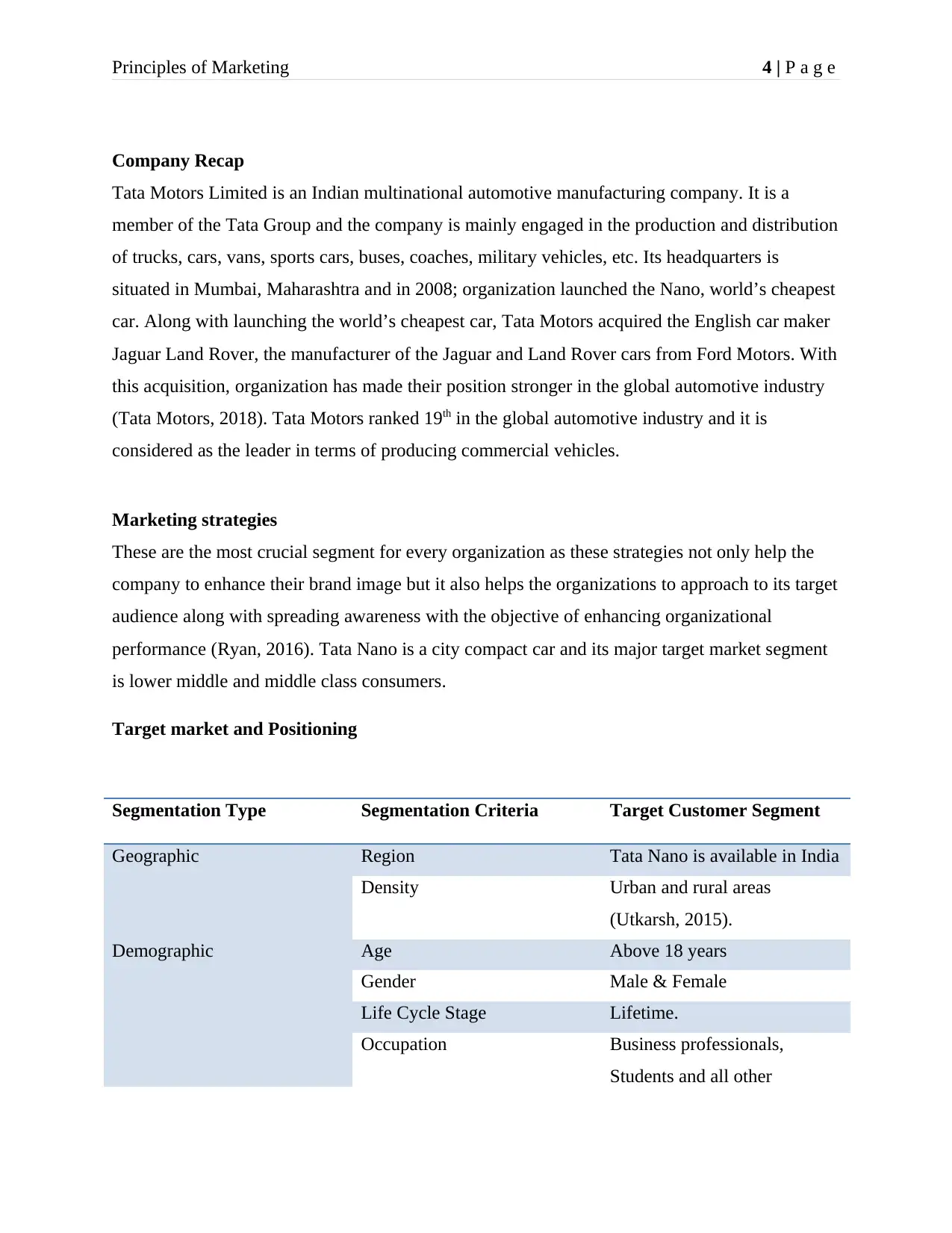
Principles of Marketing 4 | P a g e
Company Recap
Tata Motors Limited is an Indian multinational automotive manufacturing company. It is a
member of the Tata Group and the company is mainly engaged in the production and distribution
of trucks, cars, vans, sports cars, buses, coaches, military vehicles, etc. Its headquarters is
situated in Mumbai, Maharashtra and in 2008; organization launched the Nano, world’s cheapest
car. Along with launching the world’s cheapest car, Tata Motors acquired the English car maker
Jaguar Land Rover, the manufacturer of the Jaguar and Land Rover cars from Ford Motors. With
this acquisition, organization has made their position stronger in the global automotive industry
(Tata Motors, 2018). Tata Motors ranked 19th in the global automotive industry and it is
considered as the leader in terms of producing commercial vehicles.
Marketing strategies
These are the most crucial segment for every organization as these strategies not only help the
company to enhance their brand image but it also helps the organizations to approach to its target
audience along with spreading awareness with the objective of enhancing organizational
performance (Ryan, 2016). Tata Nano is a city compact car and its major target market segment
is lower middle and middle class consumers.
Target market and Positioning
Segmentation Type Segmentation Criteria Target Customer Segment
Geographic Region Tata Nano is available in India
Density Urban and rural areas
(Utkarsh, 2015).
Demographic Age Above 18 years
Gender Male & Female
Life Cycle Stage Lifetime.
Occupation Business professionals,
Students and all other
Company Recap
Tata Motors Limited is an Indian multinational automotive manufacturing company. It is a
member of the Tata Group and the company is mainly engaged in the production and distribution
of trucks, cars, vans, sports cars, buses, coaches, military vehicles, etc. Its headquarters is
situated in Mumbai, Maharashtra and in 2008; organization launched the Nano, world’s cheapest
car. Along with launching the world’s cheapest car, Tata Motors acquired the English car maker
Jaguar Land Rover, the manufacturer of the Jaguar and Land Rover cars from Ford Motors. With
this acquisition, organization has made their position stronger in the global automotive industry
(Tata Motors, 2018). Tata Motors ranked 19th in the global automotive industry and it is
considered as the leader in terms of producing commercial vehicles.
Marketing strategies
These are the most crucial segment for every organization as these strategies not only help the
company to enhance their brand image but it also helps the organizations to approach to its target
audience along with spreading awareness with the objective of enhancing organizational
performance (Ryan, 2016). Tata Nano is a city compact car and its major target market segment
is lower middle and middle class consumers.
Target market and Positioning
Segmentation Type Segmentation Criteria Target Customer Segment
Geographic Region Tata Nano is available in India
Density Urban and rural areas
(Utkarsh, 2015).
Demographic Age Above 18 years
Gender Male & Female
Life Cycle Stage Lifetime.
Occupation Business professionals,
Students and all other
Paraphrase This Document
Need a fresh take? Get an instant paraphrase of this document with our AI Paraphraser
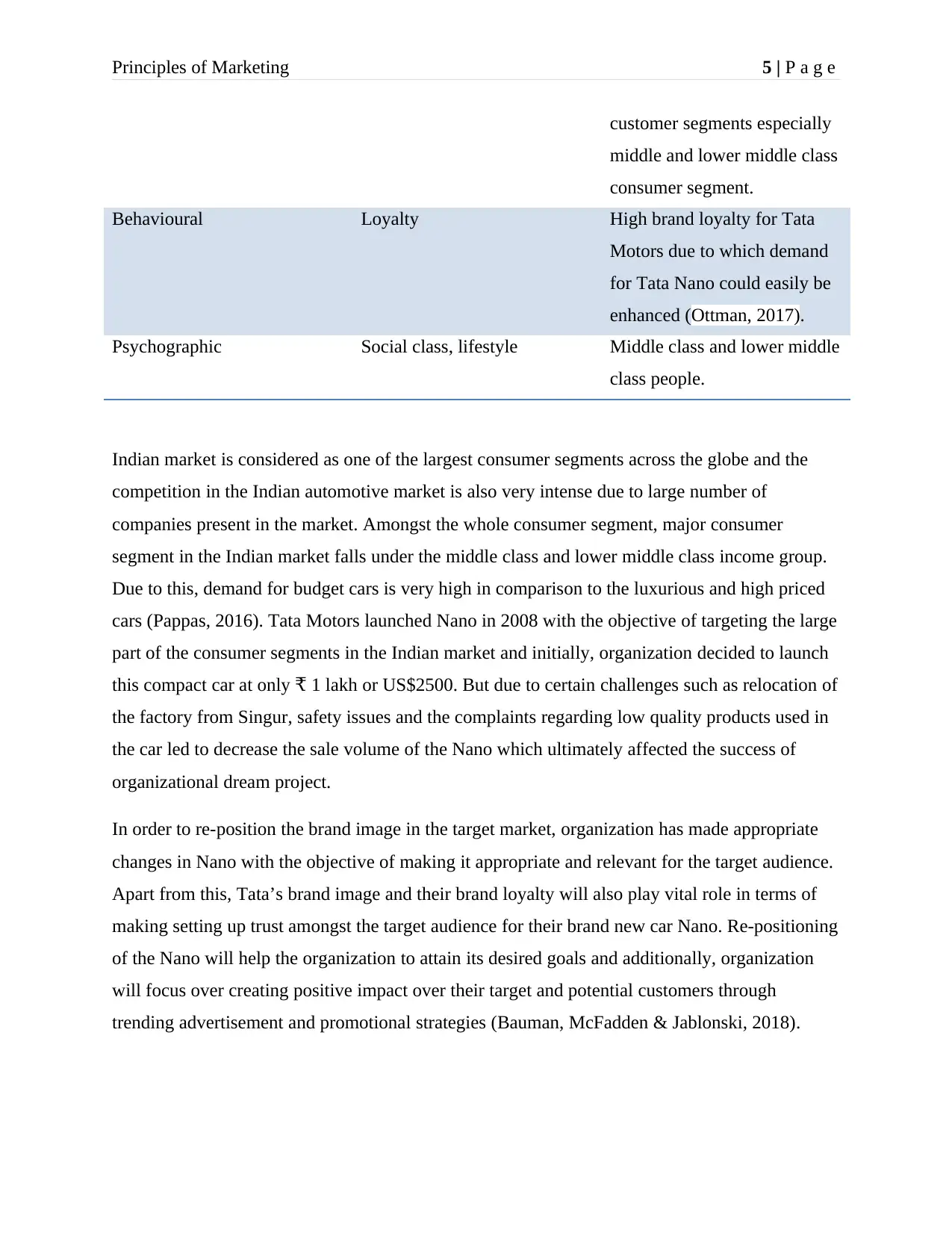
Principles of Marketing 5 | P a g e
customer segments especially
middle and lower middle class
consumer segment.
Behavioural Loyalty High brand loyalty for Tata
Motors due to which demand
for Tata Nano could easily be
enhanced (Ottman, 2017).
Psychographic Social class, lifestyle Middle class and lower middle
class people.
Indian market is considered as one of the largest consumer segments across the globe and the
competition in the Indian automotive market is also very intense due to large number of
companies present in the market. Amongst the whole consumer segment, major consumer
segment in the Indian market falls under the middle class and lower middle class income group.
Due to this, demand for budget cars is very high in comparison to the luxurious and high priced
cars (Pappas, 2016). Tata Motors launched Nano in 2008 with the objective of targeting the large
part of the consumer segments in the Indian market and initially, organization decided to launch
this compact car at only 1 lakh or US$2500. But due to certain challenges such as relocation of₹
the factory from Singur, safety issues and the complaints regarding low quality products used in
the car led to decrease the sale volume of the Nano which ultimately affected the success of
organizational dream project.
In order to re-position the brand image in the target market, organization has made appropriate
changes in Nano with the objective of making it appropriate and relevant for the target audience.
Apart from this, Tata’s brand image and their brand loyalty will also play vital role in terms of
making setting up trust amongst the target audience for their brand new car Nano. Re-positioning
of the Nano will help the organization to attain its desired goals and additionally, organization
will focus over creating positive impact over their target and potential customers through
trending advertisement and promotional strategies (Bauman, McFadden & Jablonski, 2018).
customer segments especially
middle and lower middle class
consumer segment.
Behavioural Loyalty High brand loyalty for Tata
Motors due to which demand
for Tata Nano could easily be
enhanced (Ottman, 2017).
Psychographic Social class, lifestyle Middle class and lower middle
class people.
Indian market is considered as one of the largest consumer segments across the globe and the
competition in the Indian automotive market is also very intense due to large number of
companies present in the market. Amongst the whole consumer segment, major consumer
segment in the Indian market falls under the middle class and lower middle class income group.
Due to this, demand for budget cars is very high in comparison to the luxurious and high priced
cars (Pappas, 2016). Tata Motors launched Nano in 2008 with the objective of targeting the large
part of the consumer segments in the Indian market and initially, organization decided to launch
this compact car at only 1 lakh or US$2500. But due to certain challenges such as relocation of₹
the factory from Singur, safety issues and the complaints regarding low quality products used in
the car led to decrease the sale volume of the Nano which ultimately affected the success of
organizational dream project.
In order to re-position the brand image in the target market, organization has made appropriate
changes in Nano with the objective of making it appropriate and relevant for the target audience.
Apart from this, Tata’s brand image and their brand loyalty will also play vital role in terms of
making setting up trust amongst the target audience for their brand new car Nano. Re-positioning
of the Nano will help the organization to attain its desired goals and additionally, organization
will focus over creating positive impact over their target and potential customers through
trending advertisement and promotional strategies (Bauman, McFadden & Jablonski, 2018).
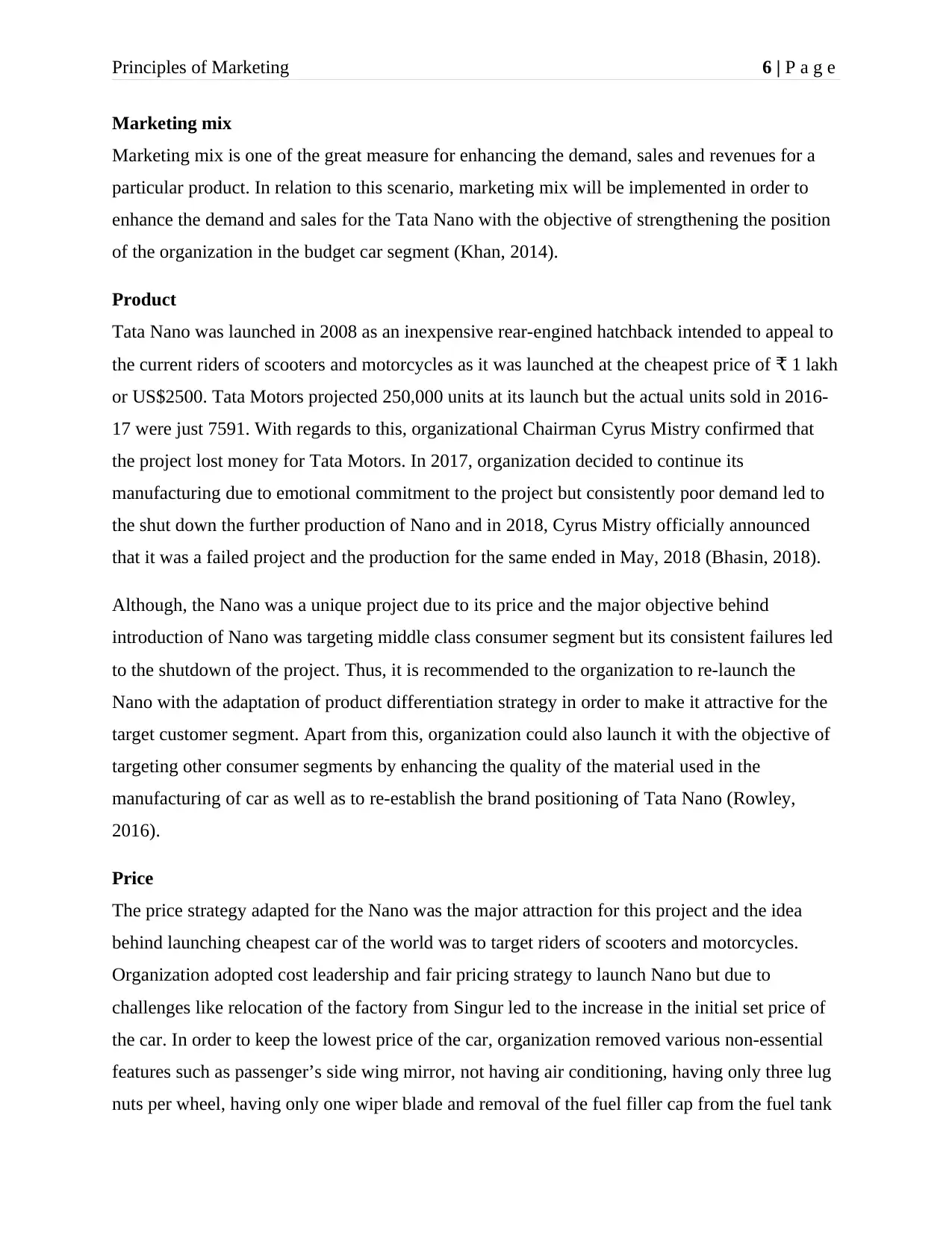
Principles of Marketing 6 | P a g e
Marketing mix
Marketing mix is one of the great measure for enhancing the demand, sales and revenues for a
particular product. In relation to this scenario, marketing mix will be implemented in order to
enhance the demand and sales for the Tata Nano with the objective of strengthening the position
of the organization in the budget car segment (Khan, 2014).
Product
Tata Nano was launched in 2008 as an inexpensive rear-engined hatchback intended to appeal to
the current riders of scooters and motorcycles as it was launched at the cheapest price of 1 lakh₹
or US$2500. Tata Motors projected 250,000 units at its launch but the actual units sold in 2016-
17 were just 7591. With regards to this, organizational Chairman Cyrus Mistry confirmed that
the project lost money for Tata Motors. In 2017, organization decided to continue its
manufacturing due to emotional commitment to the project but consistently poor demand led to
the shut down the further production of Nano and in 2018, Cyrus Mistry officially announced
that it was a failed project and the production for the same ended in May, 2018 (Bhasin, 2018).
Although, the Nano was a unique project due to its price and the major objective behind
introduction of Nano was targeting middle class consumer segment but its consistent failures led
to the shutdown of the project. Thus, it is recommended to the organization to re-launch the
Nano with the adaptation of product differentiation strategy in order to make it attractive for the
target customer segment. Apart from this, organization could also launch it with the objective of
targeting other consumer segments by enhancing the quality of the material used in the
manufacturing of car as well as to re-establish the brand positioning of Tata Nano (Rowley,
2016).
Price
The price strategy adapted for the Nano was the major attraction for this project and the idea
behind launching cheapest car of the world was to target riders of scooters and motorcycles.
Organization adopted cost leadership and fair pricing strategy to launch Nano but due to
challenges like relocation of the factory from Singur led to the increase in the initial set price of
the car. In order to keep the lowest price of the car, organization removed various non-essential
features such as passenger’s side wing mirror, not having air conditioning, having only three lug
nuts per wheel, having only one wiper blade and removal of the fuel filler cap from the fuel tank
Marketing mix
Marketing mix is one of the great measure for enhancing the demand, sales and revenues for a
particular product. In relation to this scenario, marketing mix will be implemented in order to
enhance the demand and sales for the Tata Nano with the objective of strengthening the position
of the organization in the budget car segment (Khan, 2014).
Product
Tata Nano was launched in 2008 as an inexpensive rear-engined hatchback intended to appeal to
the current riders of scooters and motorcycles as it was launched at the cheapest price of 1 lakh₹
or US$2500. Tata Motors projected 250,000 units at its launch but the actual units sold in 2016-
17 were just 7591. With regards to this, organizational Chairman Cyrus Mistry confirmed that
the project lost money for Tata Motors. In 2017, organization decided to continue its
manufacturing due to emotional commitment to the project but consistently poor demand led to
the shut down the further production of Nano and in 2018, Cyrus Mistry officially announced
that it was a failed project and the production for the same ended in May, 2018 (Bhasin, 2018).
Although, the Nano was a unique project due to its price and the major objective behind
introduction of Nano was targeting middle class consumer segment but its consistent failures led
to the shutdown of the project. Thus, it is recommended to the organization to re-launch the
Nano with the adaptation of product differentiation strategy in order to make it attractive for the
target customer segment. Apart from this, organization could also launch it with the objective of
targeting other consumer segments by enhancing the quality of the material used in the
manufacturing of car as well as to re-establish the brand positioning of Tata Nano (Rowley,
2016).
Price
The price strategy adapted for the Nano was the major attraction for this project and the idea
behind launching cheapest car of the world was to target riders of scooters and motorcycles.
Organization adopted cost leadership and fair pricing strategy to launch Nano but due to
challenges like relocation of the factory from Singur led to the increase in the initial set price of
the car. In order to keep the lowest price of the car, organization removed various non-essential
features such as passenger’s side wing mirror, not having air conditioning, having only three lug
nuts per wheel, having only one wiper blade and removal of the fuel filler cap from the fuel tank
⊘ This is a preview!⊘
Do you want full access?
Subscribe today to unlock all pages.

Trusted by 1+ million students worldwide

Principles of Marketing 7 | P a g e
(Fine, 2017). The introduction of Nano grabs much attention from the media and their target
audience due to its lowest price.
As the car did not stands on the company’s expectations and after making certain attempts to
make it successful and to generate demand for the product in the Indian market, it is
recommended to the organization to re-launch the car with batter fitted engine in order to make it
environment friendly. Pollution is the major concern for every country and the transportation
mediums are the biggest contributors for enhancing the level of pollution day-by-day, thus, the
battery fitted engine would help the organization to establish an effective brand positioning for
Tata Nano amongst the target audience.
Place
Initially, Tata Motors launched Nano in the Indian market as it is the largest consumer market
across the globe and the primary target audience for Nano was scooters and motorcycles riders.
Although, organization planned to expand the market of Nano in the international markets but
after attaining positive response from the primary target market but due to several failure
attempts, the project was limited to the Indian market only (De Mooij, 2018).
It is recommended to the Tata Motors to launch Nano in other countries across the globe where
individual disposable income of the people is low such as Bangladesh, Nepal, and other poor
Asian countries. This could help the organization to attain its desired goals along with setting off
the losses incurred in the Indian market.
Promotion
Tata Motors did not compromise with the promotion and advertisement of Tata Nano. All
possible measures were adopted along with contracting with the famous celebrities as the brand
ambassador of Nano in order to create positive impact over the target audience. Along with this,
organization also used trending mediums of advertisement such as social media platforms and
other digital media mix.
In the re-launch of the Nano, it is recommended to the organization to make it bit more attractive
by adding unique features along with making it as per the requirements and demands of
millennials. This is another big consumer segment in the Indian market and in order to target this
(Fine, 2017). The introduction of Nano grabs much attention from the media and their target
audience due to its lowest price.
As the car did not stands on the company’s expectations and after making certain attempts to
make it successful and to generate demand for the product in the Indian market, it is
recommended to the organization to re-launch the car with batter fitted engine in order to make it
environment friendly. Pollution is the major concern for every country and the transportation
mediums are the biggest contributors for enhancing the level of pollution day-by-day, thus, the
battery fitted engine would help the organization to establish an effective brand positioning for
Tata Nano amongst the target audience.
Place
Initially, Tata Motors launched Nano in the Indian market as it is the largest consumer market
across the globe and the primary target audience for Nano was scooters and motorcycles riders.
Although, organization planned to expand the market of Nano in the international markets but
after attaining positive response from the primary target market but due to several failure
attempts, the project was limited to the Indian market only (De Mooij, 2018).
It is recommended to the Tata Motors to launch Nano in other countries across the globe where
individual disposable income of the people is low such as Bangladesh, Nepal, and other poor
Asian countries. This could help the organization to attain its desired goals along with setting off
the losses incurred in the Indian market.
Promotion
Tata Motors did not compromise with the promotion and advertisement of Tata Nano. All
possible measures were adopted along with contracting with the famous celebrities as the brand
ambassador of Nano in order to create positive impact over the target audience. Along with this,
organization also used trending mediums of advertisement such as social media platforms and
other digital media mix.
In the re-launch of the Nano, it is recommended to the organization to make it bit more attractive
by adding unique features along with making it as per the requirements and demands of
millennials. This is another big consumer segment in the Indian market and in order to target this
Paraphrase This Document
Need a fresh take? Get an instant paraphrase of this document with our AI Paraphraser
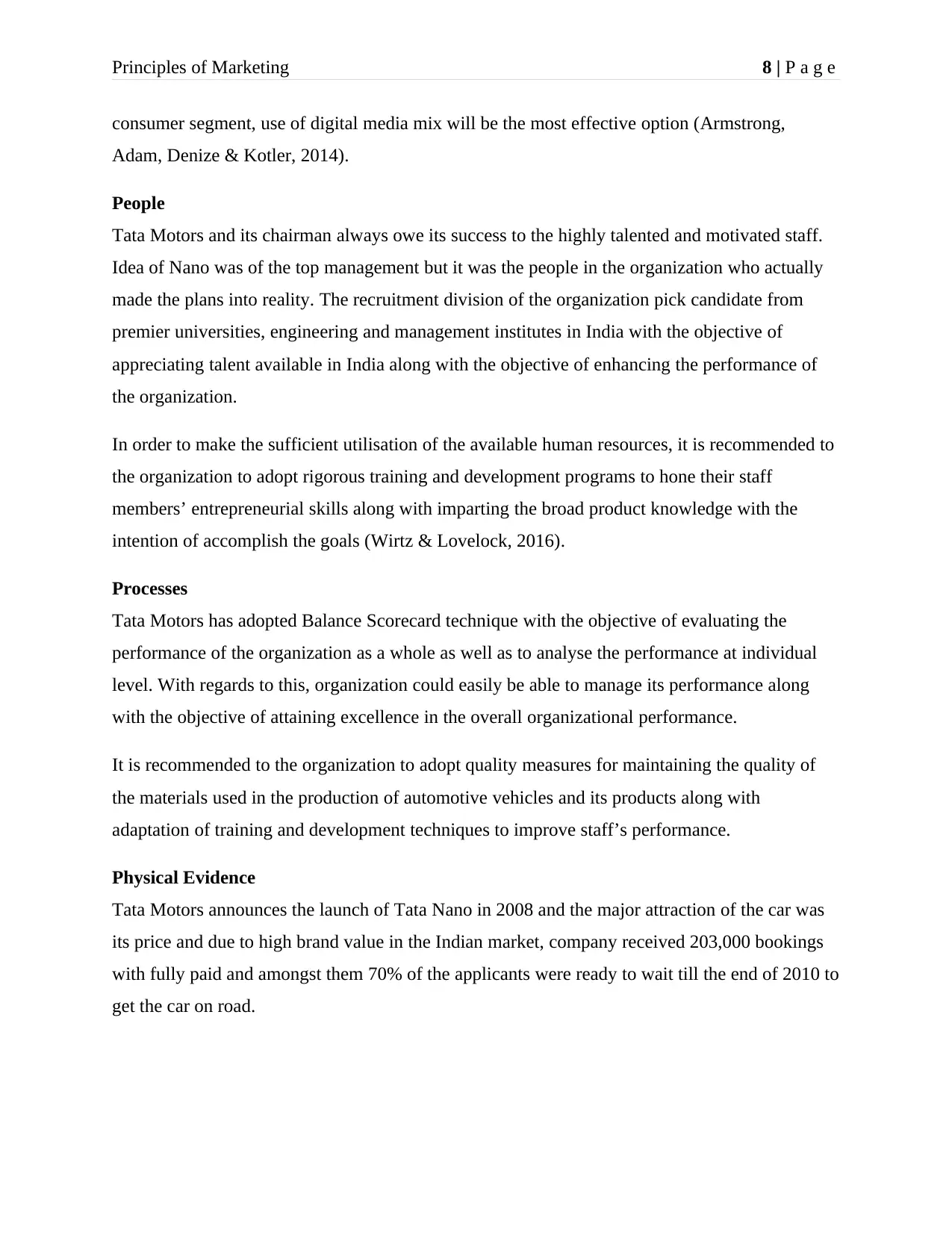
Principles of Marketing 8 | P a g e
consumer segment, use of digital media mix will be the most effective option (Armstrong,
Adam, Denize & Kotler, 2014).
People
Tata Motors and its chairman always owe its success to the highly talented and motivated staff.
Idea of Nano was of the top management but it was the people in the organization who actually
made the plans into reality. The recruitment division of the organization pick candidate from
premier universities, engineering and management institutes in India with the objective of
appreciating talent available in India along with the objective of enhancing the performance of
the organization.
In order to make the sufficient utilisation of the available human resources, it is recommended to
the organization to adopt rigorous training and development programs to hone their staff
members’ entrepreneurial skills along with imparting the broad product knowledge with the
intention of accomplish the goals (Wirtz & Lovelock, 2016).
Processes
Tata Motors has adopted Balance Scorecard technique with the objective of evaluating the
performance of the organization as a whole as well as to analyse the performance at individual
level. With regards to this, organization could easily be able to manage its performance along
with the objective of attaining excellence in the overall organizational performance.
It is recommended to the organization to adopt quality measures for maintaining the quality of
the materials used in the production of automotive vehicles and its products along with
adaptation of training and development techniques to improve staff’s performance.
Physical Evidence
Tata Motors announces the launch of Tata Nano in 2008 and the major attraction of the car was
its price and due to high brand value in the Indian market, company received 203,000 bookings
with fully paid and amongst them 70% of the applicants were ready to wait till the end of 2010 to
get the car on road.
consumer segment, use of digital media mix will be the most effective option (Armstrong,
Adam, Denize & Kotler, 2014).
People
Tata Motors and its chairman always owe its success to the highly talented and motivated staff.
Idea of Nano was of the top management but it was the people in the organization who actually
made the plans into reality. The recruitment division of the organization pick candidate from
premier universities, engineering and management institutes in India with the objective of
appreciating talent available in India along with the objective of enhancing the performance of
the organization.
In order to make the sufficient utilisation of the available human resources, it is recommended to
the organization to adopt rigorous training and development programs to hone their staff
members’ entrepreneurial skills along with imparting the broad product knowledge with the
intention of accomplish the goals (Wirtz & Lovelock, 2016).
Processes
Tata Motors has adopted Balance Scorecard technique with the objective of evaluating the
performance of the organization as a whole as well as to analyse the performance at individual
level. With regards to this, organization could easily be able to manage its performance along
with the objective of attaining excellence in the overall organizational performance.
It is recommended to the organization to adopt quality measures for maintaining the quality of
the materials used in the production of automotive vehicles and its products along with
adaptation of training and development techniques to improve staff’s performance.
Physical Evidence
Tata Motors announces the launch of Tata Nano in 2008 and the major attraction of the car was
its price and due to high brand value in the Indian market, company received 203,000 bookings
with fully paid and amongst them 70% of the applicants were ready to wait till the end of 2010 to
get the car on road.

Principles of Marketing 9 | P a g e
With the help of huge brand value, organization could re-launch the project in order to enhance
organizational performance along with the objective of setting off the losses incurred while
initial launch of the car (Baker, 2014).
With the help of huge brand value, organization could re-launch the project in order to enhance
organizational performance along with the objective of setting off the losses incurred while
initial launch of the car (Baker, 2014).
⊘ This is a preview!⊘
Do you want full access?
Subscribe today to unlock all pages.

Trusted by 1+ million students worldwide
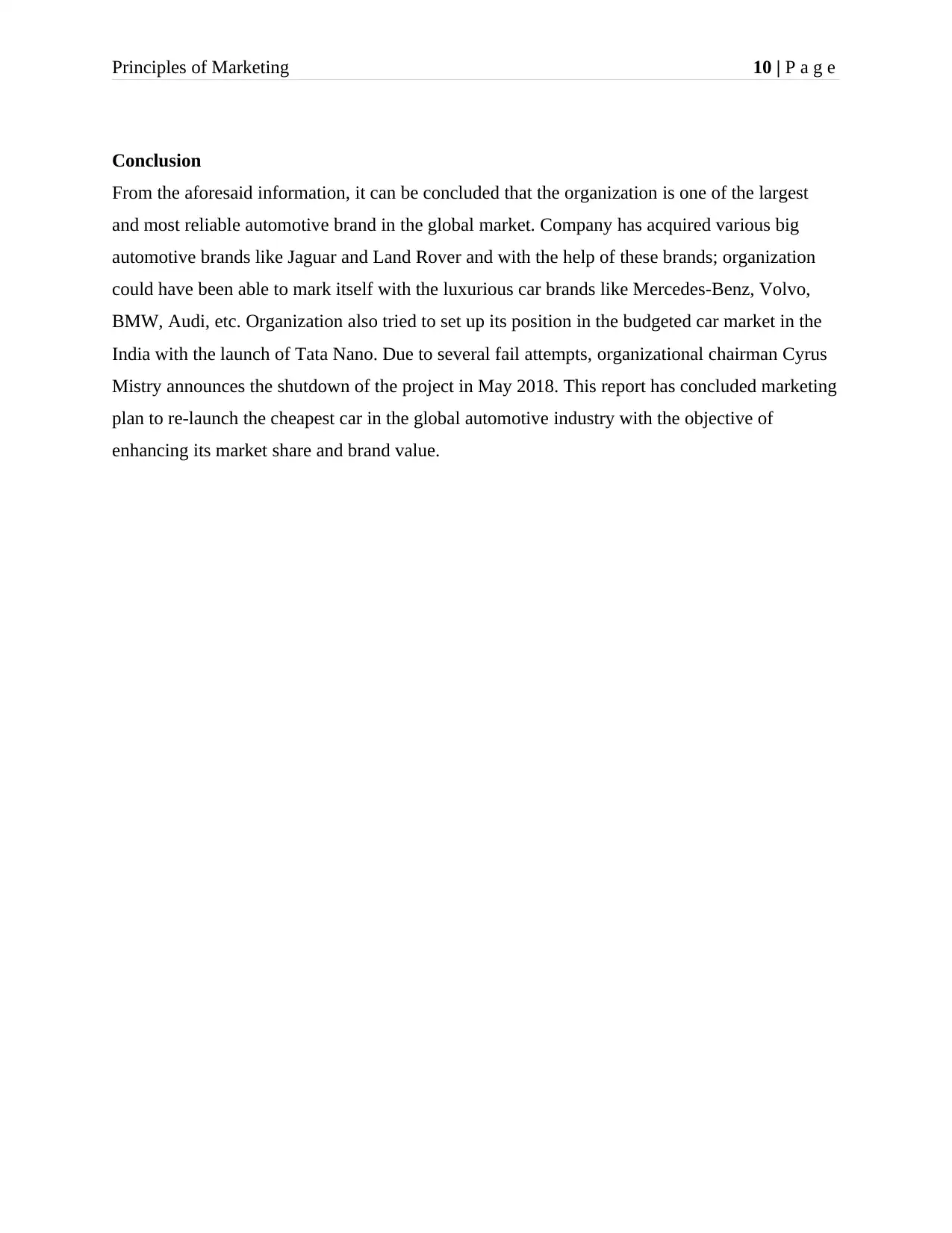
Principles of Marketing 10 | P a g e
Conclusion
From the aforesaid information, it can be concluded that the organization is one of the largest
and most reliable automotive brand in the global market. Company has acquired various big
automotive brands like Jaguar and Land Rover and with the help of these brands; organization
could have been able to mark itself with the luxurious car brands like Mercedes-Benz, Volvo,
BMW, Audi, etc. Organization also tried to set up its position in the budgeted car market in the
India with the launch of Tata Nano. Due to several fail attempts, organizational chairman Cyrus
Mistry announces the shutdown of the project in May 2018. This report has concluded marketing
plan to re-launch the cheapest car in the global automotive industry with the objective of
enhancing its market share and brand value.
Conclusion
From the aforesaid information, it can be concluded that the organization is one of the largest
and most reliable automotive brand in the global market. Company has acquired various big
automotive brands like Jaguar and Land Rover and with the help of these brands; organization
could have been able to mark itself with the luxurious car brands like Mercedes-Benz, Volvo,
BMW, Audi, etc. Organization also tried to set up its position in the budgeted car market in the
India with the launch of Tata Nano. Due to several fail attempts, organizational chairman Cyrus
Mistry announces the shutdown of the project in May 2018. This report has concluded marketing
plan to re-launch the cheapest car in the global automotive industry with the objective of
enhancing its market share and brand value.
Paraphrase This Document
Need a fresh take? Get an instant paraphrase of this document with our AI Paraphraser
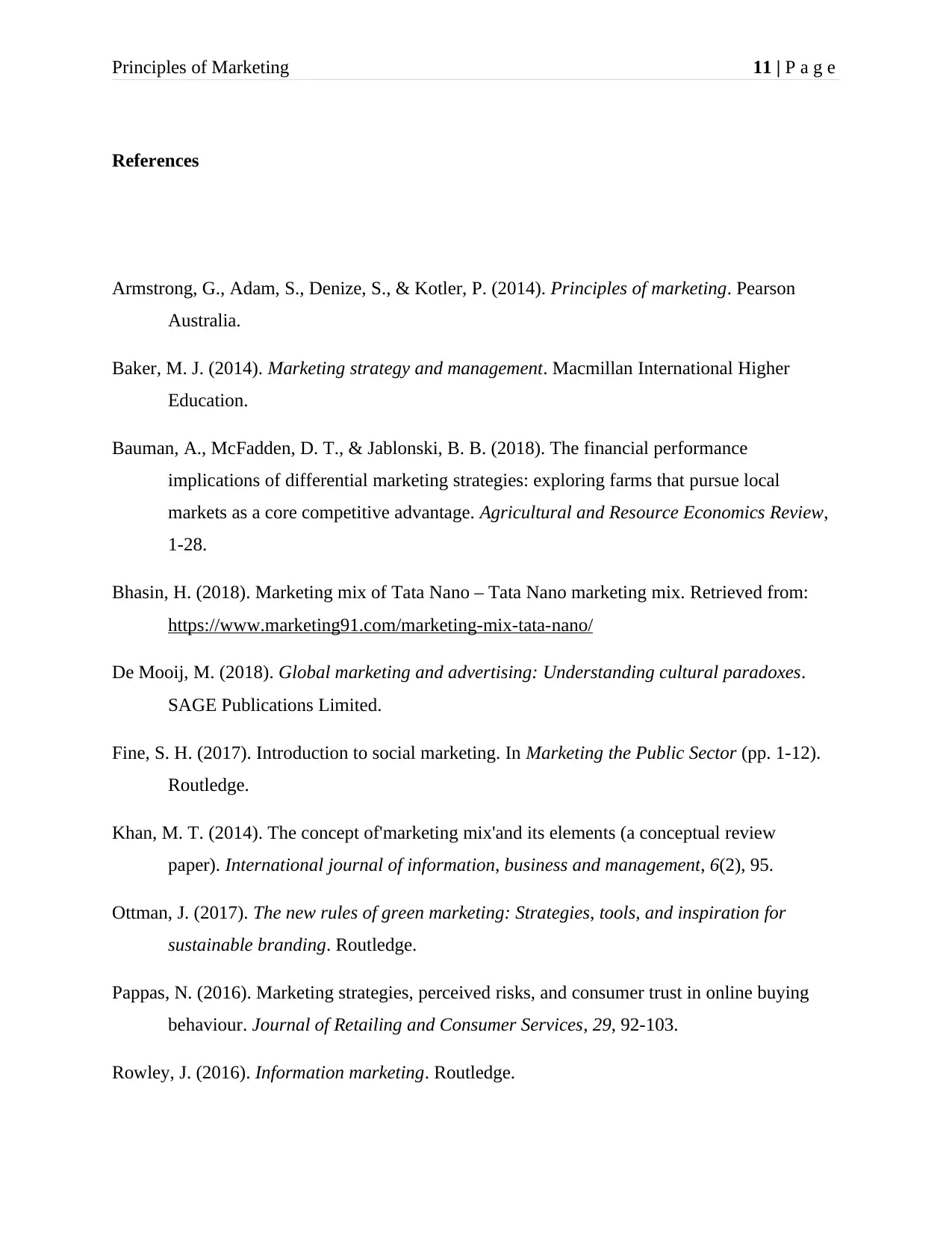
Principles of Marketing 11 | P a g e
References
Armstrong, G., Adam, S., Denize, S., & Kotler, P. (2014). Principles of marketing. Pearson
Australia.
Baker, M. J. (2014). Marketing strategy and management. Macmillan International Higher
Education.
Bauman, A., McFadden, D. T., & Jablonski, B. B. (2018). The financial performance
implications of differential marketing strategies: exploring farms that pursue local
markets as a core competitive advantage. Agricultural and Resource Economics Review,
1-28.
Bhasin, H. (2018). Marketing mix of Tata Nano – Tata Nano marketing mix. Retrieved from:
https://www.marketing91.com/marketing-mix-tata-nano/
De Mooij, M. (2018). Global marketing and advertising: Understanding cultural paradoxes.
SAGE Publications Limited.
Fine, S. H. (2017). Introduction to social marketing. In Marketing the Public Sector (pp. 1-12).
Routledge.
Khan, M. T. (2014). The concept of'marketing mix'and its elements (a conceptual review
paper). International journal of information, business and management, 6(2), 95.
Ottman, J. (2017). The new rules of green marketing: Strategies, tools, and inspiration for
sustainable branding. Routledge.
Pappas, N. (2016). Marketing strategies, perceived risks, and consumer trust in online buying
behaviour. Journal of Retailing and Consumer Services, 29, 92-103.
Rowley, J. (2016). Information marketing. Routledge.
References
Armstrong, G., Adam, S., Denize, S., & Kotler, P. (2014). Principles of marketing. Pearson
Australia.
Baker, M. J. (2014). Marketing strategy and management. Macmillan International Higher
Education.
Bauman, A., McFadden, D. T., & Jablonski, B. B. (2018). The financial performance
implications of differential marketing strategies: exploring farms that pursue local
markets as a core competitive advantage. Agricultural and Resource Economics Review,
1-28.
Bhasin, H. (2018). Marketing mix of Tata Nano – Tata Nano marketing mix. Retrieved from:
https://www.marketing91.com/marketing-mix-tata-nano/
De Mooij, M. (2018). Global marketing and advertising: Understanding cultural paradoxes.
SAGE Publications Limited.
Fine, S. H. (2017). Introduction to social marketing. In Marketing the Public Sector (pp. 1-12).
Routledge.
Khan, M. T. (2014). The concept of'marketing mix'and its elements (a conceptual review
paper). International journal of information, business and management, 6(2), 95.
Ottman, J. (2017). The new rules of green marketing: Strategies, tools, and inspiration for
sustainable branding. Routledge.
Pappas, N. (2016). Marketing strategies, perceived risks, and consumer trust in online buying
behaviour. Journal of Retailing and Consumer Services, 29, 92-103.
Rowley, J. (2016). Information marketing. Routledge.
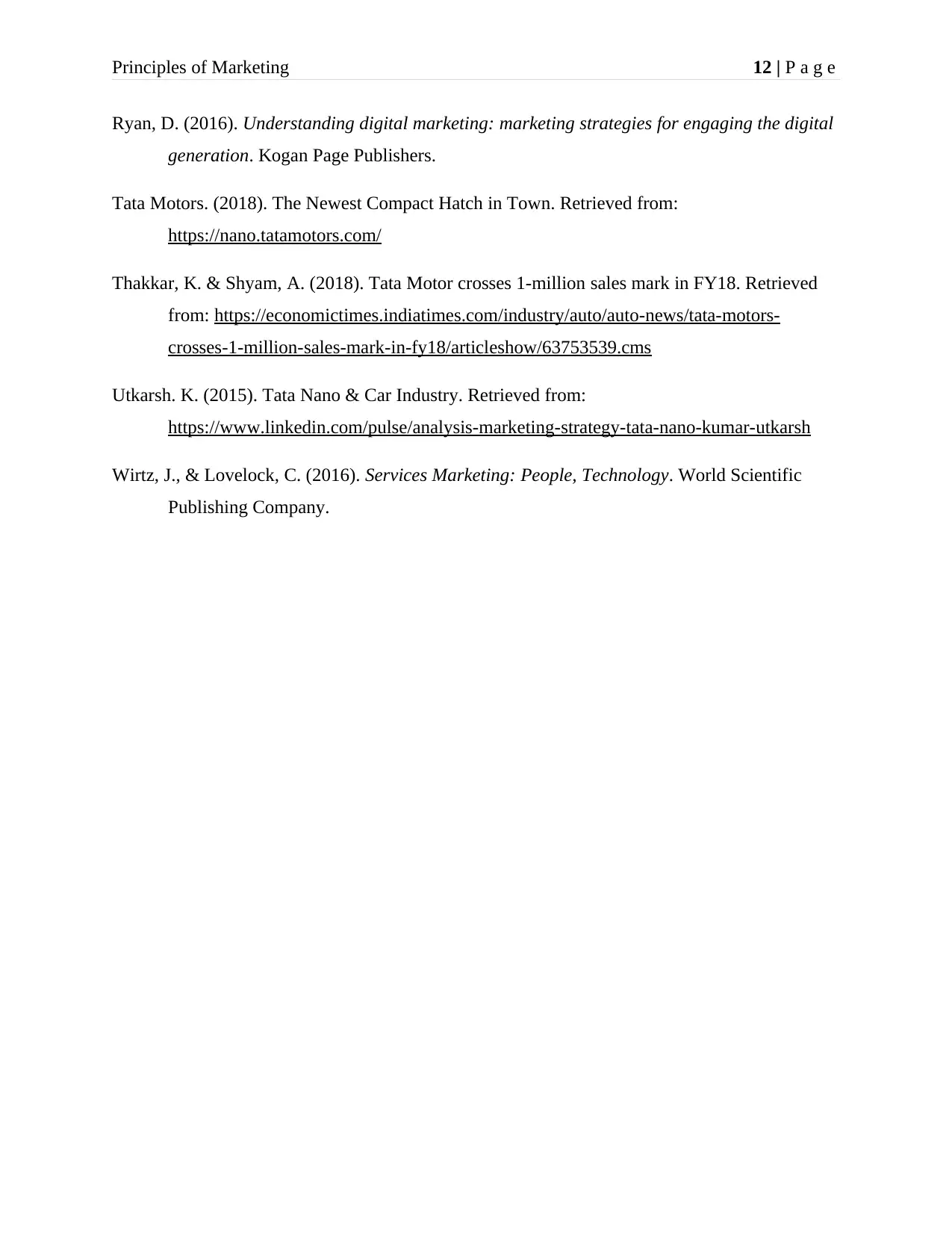
Principles of Marketing 12 | P a g e
Ryan, D. (2016). Understanding digital marketing: marketing strategies for engaging the digital
generation. Kogan Page Publishers.
Tata Motors. (2018). The Newest Compact Hatch in Town. Retrieved from:
https://nano.tatamotors.com/
Thakkar, K. & Shyam, A. (2018). Tata Motor crosses 1-million sales mark in FY18. Retrieved
from: https://economictimes.indiatimes.com/industry/auto/auto-news/tata-motors-
crosses-1-million-sales-mark-in-fy18/articleshow/63753539.cms
Utkarsh. K. (2015). Tata Nano & Car Industry. Retrieved from:
https://www.linkedin.com/pulse/analysis-marketing-strategy-tata-nano-kumar-utkarsh
Wirtz, J., & Lovelock, C. (2016). Services Marketing: People, Technology. World Scientific
Publishing Company.
Ryan, D. (2016). Understanding digital marketing: marketing strategies for engaging the digital
generation. Kogan Page Publishers.
Tata Motors. (2018). The Newest Compact Hatch in Town. Retrieved from:
https://nano.tatamotors.com/
Thakkar, K. & Shyam, A. (2018). Tata Motor crosses 1-million sales mark in FY18. Retrieved
from: https://economictimes.indiatimes.com/industry/auto/auto-news/tata-motors-
crosses-1-million-sales-mark-in-fy18/articleshow/63753539.cms
Utkarsh. K. (2015). Tata Nano & Car Industry. Retrieved from:
https://www.linkedin.com/pulse/analysis-marketing-strategy-tata-nano-kumar-utkarsh
Wirtz, J., & Lovelock, C. (2016). Services Marketing: People, Technology. World Scientific
Publishing Company.
⊘ This is a preview!⊘
Do you want full access?
Subscribe today to unlock all pages.

Trusted by 1+ million students worldwide
1 out of 12
Related Documents
Your All-in-One AI-Powered Toolkit for Academic Success.
+13062052269
info@desklib.com
Available 24*7 on WhatsApp / Email
![[object Object]](/_next/static/media/star-bottom.7253800d.svg)
Unlock your academic potential
Copyright © 2020–2025 A2Z Services. All Rights Reserved. Developed and managed by ZUCOL.





